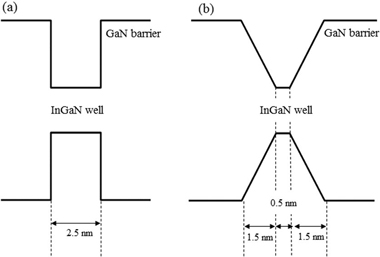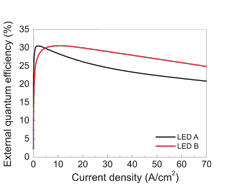
| Home | About Us | Contribute | Bookstore | Advertising | Subscribe for Free NOW! |
| News Archive | Features | Events | Recruitment | Directory |
News
6 September 2010
Trapezoid wells effect reduced LED droop and lower cross-over point
Researchers at the Gwangju Institute of Science and Technology and Samsung LED in the Republic of Korea have used non-rectangular quantum wells to reduce the efficiency droop effects in blue light-emitting diodes [Sang-Heon Han et al, J. Phys. D: Appl. Phys., vol43, p354004, 2010].
A further positive feature of the ‘trapezoidal-well’ devices that have been produced is that they emitted more light at lower currents than conventional rectangle-well LEDs produced for comparison. As is usually the case, the conventional LED performed better at very low current densities. However, the cross-over point for improved performance from the trapezoidal structure was very low — a current density of just 5A/cm2. With other attempts at reducing droop effects, the cross-over point can be as high as 80A/cm2.
Metal-organic chemical vapor deposition (MOCVD) was used to grow the nitride layers on sapphire substrates. The initial 30nm gallium nitride (GaN) buffer was grown at 570°C, followed by high-temperature annealing. Then 5μm layers of undoped and silicon-doped GaN were grown at 1150°C. The multi-quantum well consisted of five pairs of indium gallium nitride (InGaN) wells (820°C) with GaN barriers (900°C). The trapezoidal wells (Figure 1) were formed by grading the indium fraction for 1.5nm, growing at constant In fraction for 0.5nm, and finishing by grading back to GaN for another 1.5nm. The GaN barriers were 7nm thick. For comparison purposes, LEDs with rectangular wells with InGaN well layers of 2.5nm thickness were also grown. The grading was achieved by varying the flow rate of the trimethyl-indium source. After the wells, a 40nm aluminum gallium nitride (AlGaN) electron-blocking layer and n-GaN contact layers were applied.

Figure 1: Schematic band diagrams of MQWs of (a) rectangular-shaped well and (b) trapezoidal-shaped well.
The LEDs were made by etching 550μm x 550μm mesas from the material with inductively coupled plasma to expose the n-GaN layer for contacting. The p-GaN layer was coated with indium tin oxide transparent conductor material.
The dominant wavelength of the LED at 20mA injection current was 440nm (blue). The light output power was measured in an integrating sphere so that absolute values could be obtained. The devices were operated in 1ms pulsed mode to avoid self-heating effects. No encapsulation was used.
 The maximum external quantum efficiencies were 30.5% at 2A/cm2 and 30.6% at 12A/cm2 for the conventional and trapezoidal LEDs, respectively. In additional to having its maximum EQE at higher injection current density, the fall-off beyond the maximum is slower in the trapezoidal device (Figure 2).
The maximum external quantum efficiencies were 30.5% at 2A/cm2 and 30.6% at 12A/cm2 for the conventional and trapezoidal LEDs, respectively. In additional to having its maximum EQE at higher injection current density, the fall-off beyond the maximum is slower in the trapezoidal device (Figure 2).
Figure 2: External quantum efficiency vs current density for rectangular-well LED A and trapezoidal-well LED B.
Between current densities of 35A/cm2 and 70A/cm2 (corresponding to 350mA and 700mA for 1mm x 1mm devices), the EQE of the trapezoidal device is better than the conventional device. The drop in EQE compared with the respective maximum at 70A/cm2 is 32% for the conventional LED and 19% for the trapezoidal structure. The forward voltage for the trapezoidal structure was also lower than for the rectangular well LED — 4.07V compared with 4.17V at 200mA (66A/cm2) — giving calculated series resistances of 4.8Ω and 5.2Ω, respectively.
The researchers also performed simulations in an effort to understand how the trapezoidal structure improves performance. The model included the strain-dependent piezoelectric polarization fields that are particularly strong in nitride materials. These fields tend to pull the electrons and holes apart, reducing their chances of recombining to produce light. The overlap of the electron and hole wavefunctions were found to be increased in the trapezoidal structure: 41.6% rather than 37.2% for the conventional rectangular wells. The distance between the maxima was also decreased from 1.5nm to 1.1nm.
Although other researchers have found that increasing the volume of wells can improve light emission, the Korean group point out that their trapezoidal wells are effectively 20% smaller in volume compared with those of the rectangular device. The group comments: “This indicates that the decreased piezoelectric field in trapezoidal wells at high current densities has a more dominant effect on the improvement of efficiency droop compared with the non-radiative Auger effect.”
The Auger effect is a recombination mechanism that is often used to explain nitride LED efficiency droop. It involves recombination of the charge carriers that is effected by transferring the energy released to another carrier rather than emitting light. The pure Auger effect is expected to have a very small coefficient, but some researchers believe that it can be enhanced by resonant effects, particularly in longer-wavelength (e.g. green) devices.
See related items:
Semipolar blue LED with 39.5% external quantum efficiency
InAlN provides better electron-blocking layer in nitride LEDs
Tunneling a way to understand efficiency droop in InGaN LEDs
Auger largely responsible for limited LED efficiency
InGaN LED spillover and efficiency droop
![]() Search: Blue LEDs LED droop Quantum wells
Search: Blue LEDs LED droop Quantum wells
GaN InGaN
Visit: http://iopscience.iop.org
For more LED news: Latest issue of Semiconductor Today
The author Mike Cooke is a freelance technology journalist who has worked in the semiconductor and advanced technology sectors since 1997.